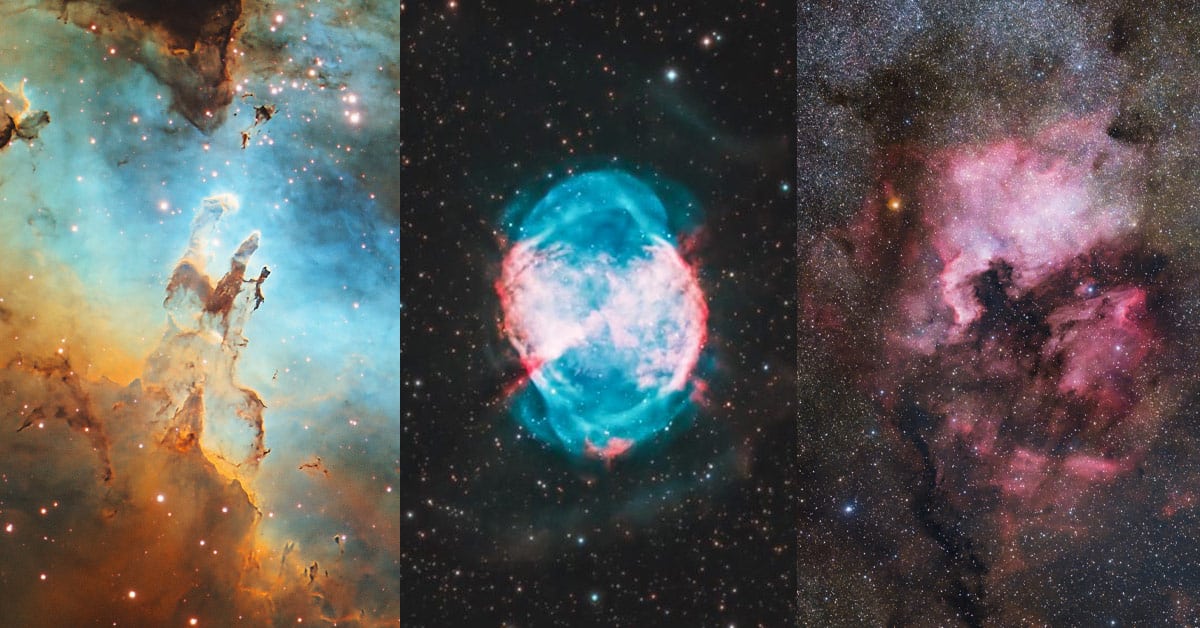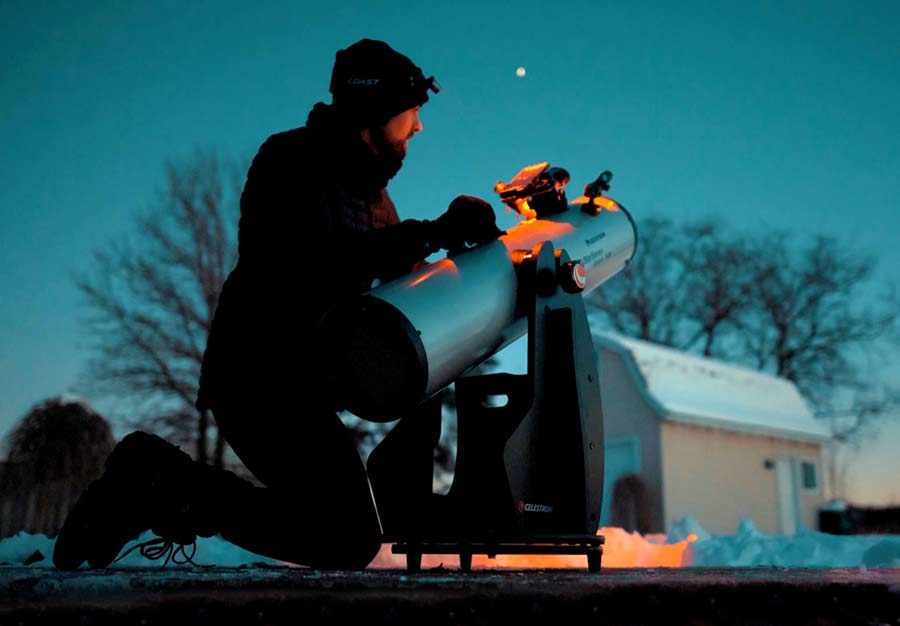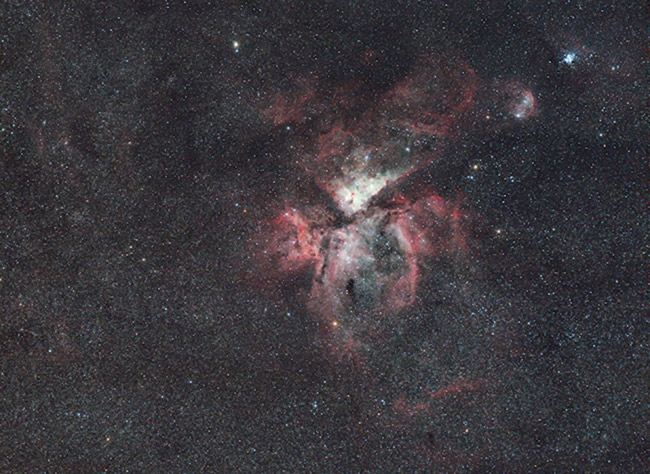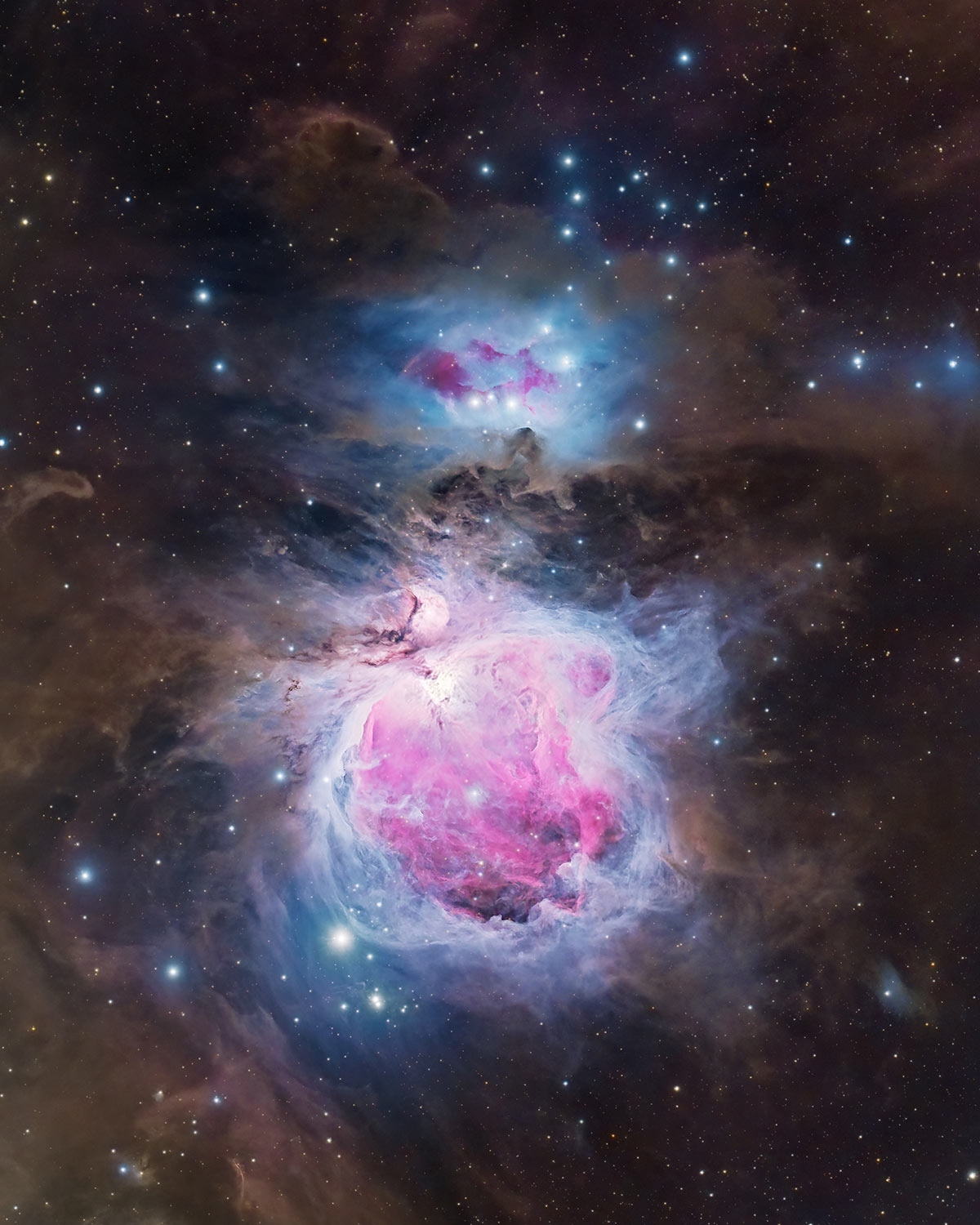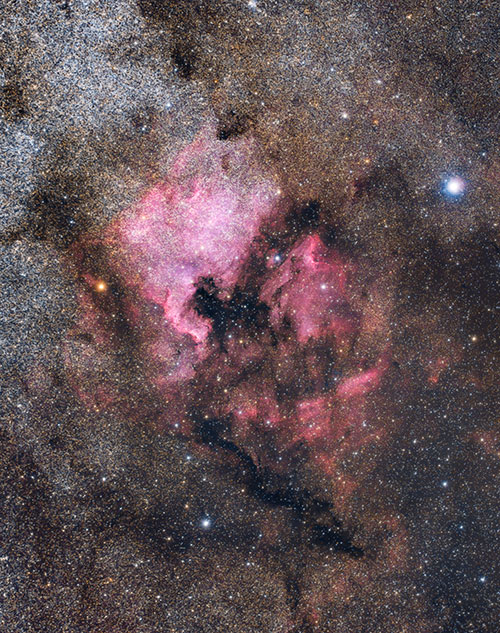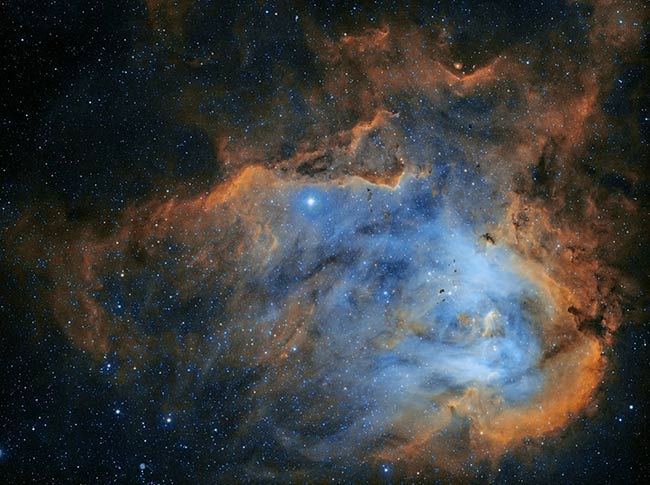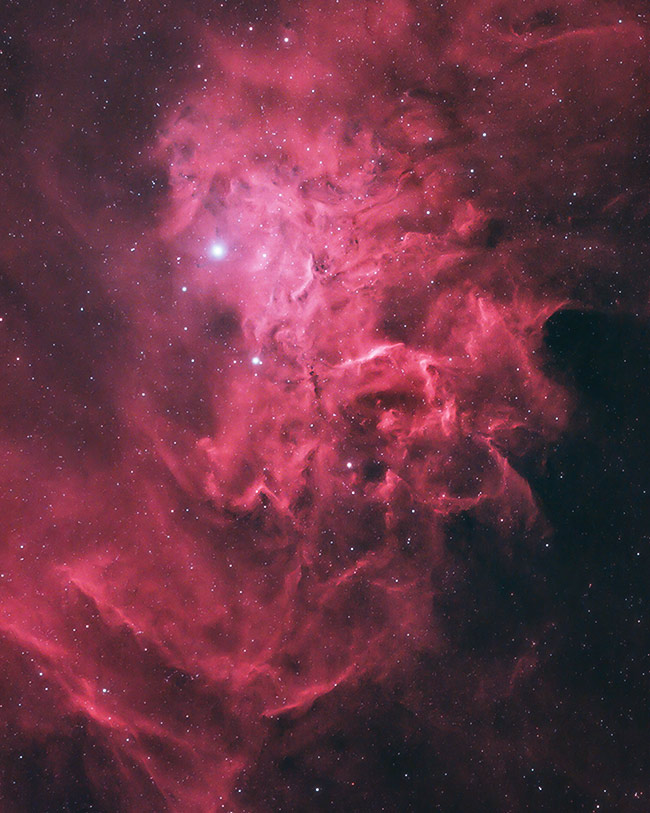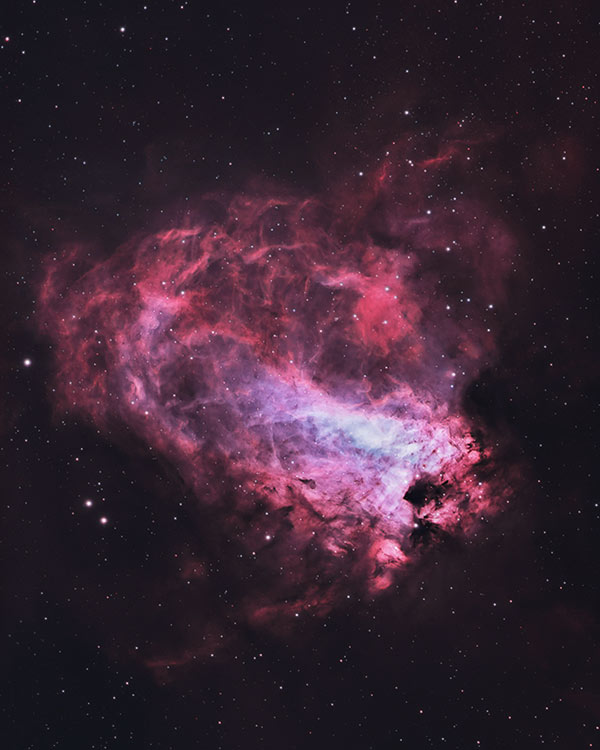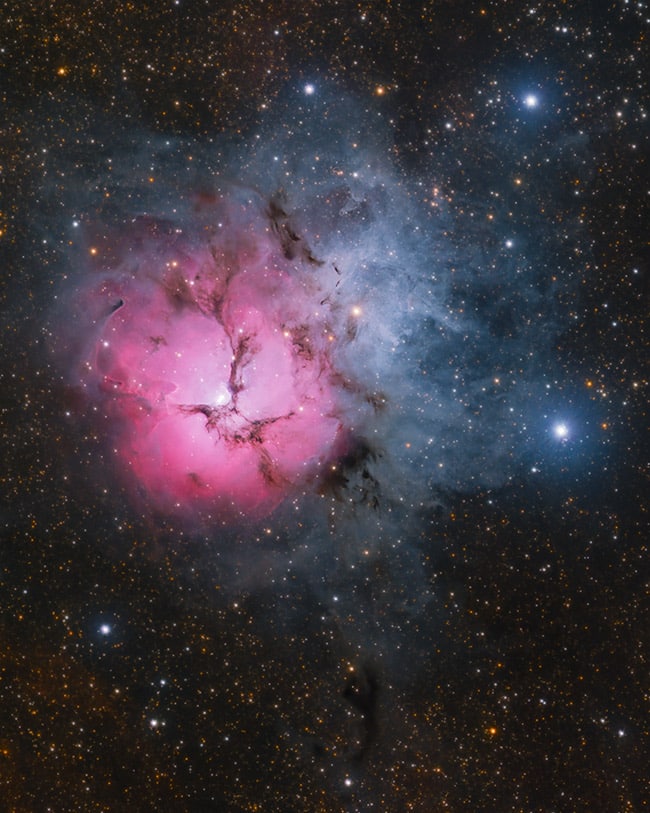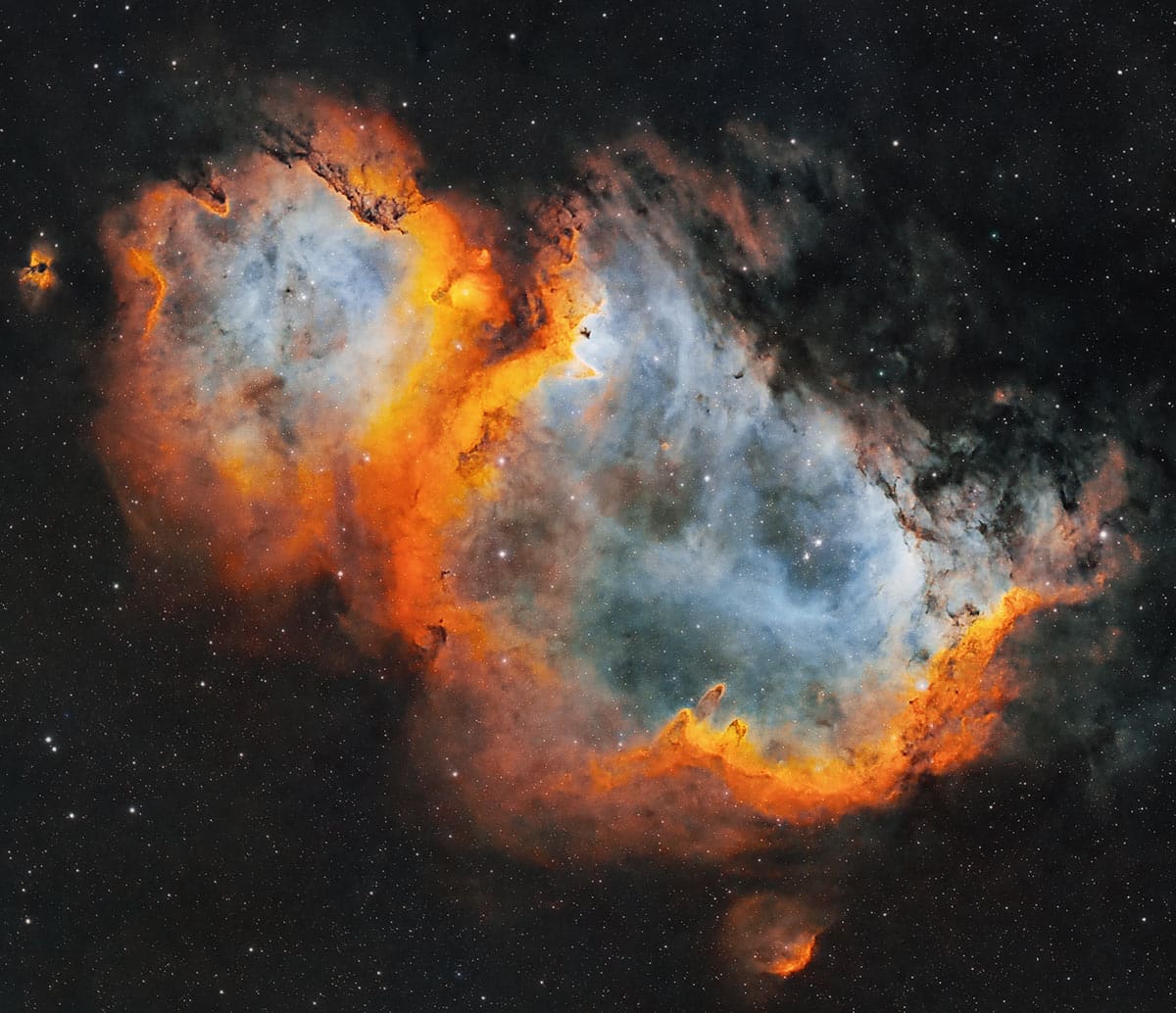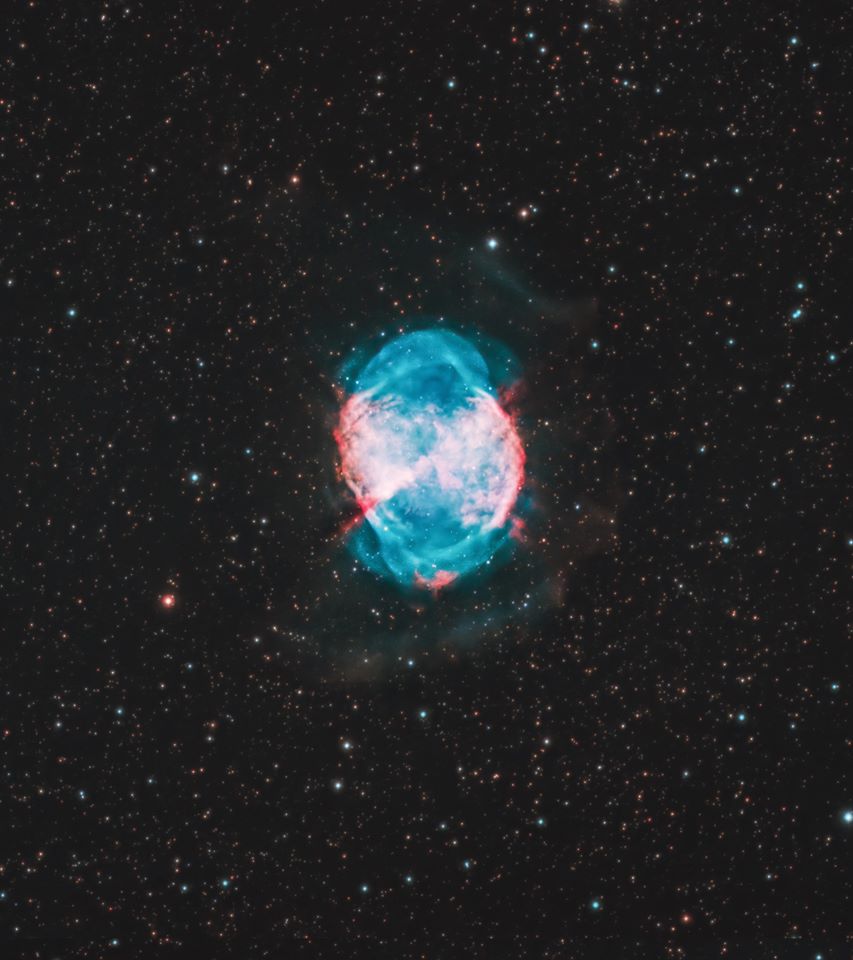Brightest Nebulae in the Night Sky
Below is a list of the brightest nebulae in the night sky based on available apparent magnitude values. Any of these objects would make great deep-sky targets.
- Carina Nebula (Mag 1)
- North America Nebula (Mag 4)
- Orion Nebula (Mag 4)
- Running Chicken Nebula (Mag 4.5)
- Lagoon Nebula (Mag 6)
- California Nebula (Mag 6)
- Flaming Star Nebula (Mag 6)
- Eagle Nebula (Mag 6)
- Omega Nebula (Mag 6)
- Homunculus Nebula (Mag 6.2)
- Trifid Nebula (Mag 6.3)
- Soul Nebula (Mag 6.5)
- Dumbbell Nebula (Mag 7.5)
If you just bought a new telescope, you’re probably hoping to observe (or photograph) some of the brightest nebulae in the night sky. Luckily, there are several great targets in the night sky to choose from.
Nebulae are massive clouds of dust and gas that can be categorized into several different types, including emission nebula, planetary nebula, reflection nebula, dark nebula, and supernova remnant.
Due to their size, varying color combinations, and compositions, these are my favorite types of deep-sky objects to photograph. They also happen to make great targets for beginners.
Bright objects like Nebulae make great targets for beginner deep-sky astrophotographers because they are easier to focus, frame, and process than dimmer, smaller objects.
A Dobsonian telescope with an aperture of at least 8 inches is recommended to observe the following nebulae.
1) Carina Nebula
The Carina Nebula is one of the brightest nebulae in the night sky. It is a massive star-forming region that measures over 300 light-years across, displaying beautifully bright and dark nebulosity.
This Southern Hemisphere target is four times larger than the Orion Nebula, a popular Northern Hemisphere deep-sky target. I have only had the chance to shoot the Carina Nebula once when traveling to lower latitudes in Costa Rica.
Designation: NGC 3372
Constellation: Carina
Apparent Magnitude: 1.0
Category: Nebula with open cluster
Distance: 8,000 light-years
Recommended focal length: 300mm
Best time to photograph: May – August
Carina Nebula from Costa Rica (18 x 30-second images at ISO 6400)
2) Orion Nebula
The Orion Nebula, at 1,500 light-years away, is the closest star-forming region to Earth and one of the brightest nebulae in the night sky. Due to its brightness and location below Orion’s Belt, it can also be seen with the naked eye.
This beginner-friendly target can be photographed with a DSLR camera and/or telescope with short unguided exposures. Learn more about photographing the Orion Nebula and processing your images using a high-dynamic range tutorial.
Designation: Messier 42/M42, NGC 1976
Constellation: Orion
Apparent Magnitude: 4.0
Category: Emission Nebula
Distance: 1,500 light-years
Recommended focal length: 400mm
Best time to photograph: December – February
Orion Nebula and Running Man Nebula
3) North America Nebula
The North America Nebula is an emission nebula located in the constellation Cygnus, near the bright star Deneb. This nebula covers an area more than four times the size of the full moon and makes a great wide-field target thanks to the emission of hydrogen gas, which gives nebulae their red color.
As you may have already guessed, this nebula was named after its characteristic shape resembling the continent of North America. If this target is next on your list, be sure to read more about photographing the North America Nebula.
Designation: NGC 7000, Caldwell 20
Constellation: Cygnus
Apparent Magnitude: 4.0
Category: Emission Nebula
Distance: 1,600 light-years
Recommended focal length: 350mm
Best time to photograph: June – September
North America Nebula (left) and neighboring Pelican Nebula (right)
4) Running Chicken Nebula
The Running Chicken Nebula, also known as IC 2944, is an emission nebula in the constellation Centaurus. It spans approximately 100 light-years and contains newborn stars that are formed in objects known as Bok globules, appearing as dark clouds.
As a Southern Hemisphere target, I have not photographed the Running Chicken Nebula.
Designation: IC 2944
Constellation: Centaurus
Apparent Magnitude: 4.5
Category: Emission Nebula
Distance: 6,000 light-years
Recommended focal length: 500mm
Best time to photograph: N/A
Running Chicken Nebula by Cody Shuttleworth
5) Lagoon Nebula
The Lagoon Nebula is an emission nebula and star-forming region in the constellation Sagittarius. It is three times the size of the full moon and the largest nebula in Sagittarius. Much like the other nebulae listed above and below, the bright colors and combination of stars and hydrogen gas make this a stunning deep-sky target.
I have photographed the Lagoon Nebula through a telescope and using a $200 camera lens. It has also been the subject of one of my image processing tutorials.
Designation: Messier 8/M8, NGC 6523, Sharpless 25
Constellation: Sagittarius
Apparent Magnitude: 6.0
Category: Nebula with open star cluster
Distance: 5,000 light-years
Recommended focal length: 450mm
Best time to photograph: June – August
Lagoon Nebula with an astronomy camera and telescope
6) California Nebula
Another nebula named after its characteristic shape, the California Nebula is located near The Pleiades in the constellation Perseus. It is a large gas cloud with a total mass of 200 suns. At approximately 1,000 light-years long, this nebula is a popular wide-field target among astrophotographers, even though it is difficult to see visually.
Learn more about photographing the California Nebula.
Designation: NGC 1499, Sharpless 220
Constellation: Perseus
Apparent Magnitude: 6.0
Category: Emission Nebula
Distance: 1,000 light-years
Recommended focal length: 250mm
Best time to photograph: November – January
The California Nebula
7) Flaming Star Nebula
The Flaming Star Nebula is an emission and reflection nebula located in the constellation Auriga. This nebula spans five light-years across and surrounds the blueish O-type main sequence dwarf star named AE Aurigae.
The ionized ultraviolet light from AE Auriga, and the presence of hydrogen gas, are responsible for the red glow. The dust area closer to the star appears blue from the reflection of the starlight. For more tips on shooting this target, check out my Flaming Star Nebula post.
Designation: IC 405, SH 2-229, Caldwell 31
Constellation: Auriga
Apparent Magnitude: 6.0
Category: Emission/Reflection Nebula
Distance: 1,500 light-years
Recommended focal length: 400mm
Best time to photograph: November – February
Flaming Star Nebula and the AE Aurigae star in the constellation Auriga
8) Eagle Nebula
The Eagle Nebula is a cloud of hydrogen gas and dust spanning roughly 70 light-years by 5 light-years. It contains several active star-forming regions, including the ‘Pillars of Creation‘, which was made famous by the Hubble Space Telescope.
This region of the Eagle Nebula includes three giant gas columns that stretch 4 light-years into space. Learn more about capturing the Eagle Nebula with a DSLR and telescope.
Designation: Messier 16/M16, NGC 6611
Constellation: Sepens
Apparent Magnitude: 6.0
Category: Nebula with open star cluster
Distance: 7,000 light-years
Recommended focal length: 500mm
Best time to photograph: June – September
Eagle Nebula and Pillars of Creation star-forming region
9) Omega Nebula
The Omega Nebula, also known as the Swan Nebula, is one of the largest star-forming regions in our galaxy. It is similar in geometry to the Orion Nebula, but the Omega Nebula appears edge-on, rather than face-on, when observed from Earth.
It spans 15 light-years in diameter and appears red in color from hydrogen gas being lit up by newly formed stars. Learn more about photographing the Omega Nebula.
Designation: Messier 17/ M17, NGC 6618, Sharpless 45
Constellation: Sagittarius
Apparent Magnitude: 6.0
Category: Emission Nebula
Distance: 5,500 light-years
Recommended focal length: 600mm
Best time to photograph: June – August
Omega/Swan Nebula
10) Homunculus Nebula
The Homunculus Nebula is a reflection nebula located in the larger Carina Nebula. It surrounds the massive star system Eta Carinae, which is nearly 4 million times brighter than the Sun. The ‘Great Eruption‘ of Eta Carinae resulted in the creation of the Homunculus Nebula and its strange bipolar configuration.
As a Southern Hemisphere target, I have no experience photographing this particular nebula.
Designation: N/A
Constellation: Carina
Apparent Magnitude: 6.2
Category: Reflection Nebula
Distance: 7,500 light-years
Recommended focal length: N/A
Best time to photograph: N/A
Homunculus Nebula and Eta Carinae |
11) Trifid Nebula
The Trifid Nebula is one of the youngest star-forming regions in our sky. It includes a unique combination of different types of nebulae – a red emission nebula (hydrogen), a blue reflection nebula (dust reflected by starlight), and a dark nebula (apparent ‘gaps’ in the dense dust).
It was named after the three distinct bands or lobes of thick dust and is often photographed with its neighbor, the Lagoon Nebula. Get more information on photographing this popular deep-sky target here.
Designation: Messier 20/M20, NGC 6514, Sharpless 30
Constellation: Sagittarius
Apparent Magnitude: 6.3
Category: Nebula with open star cluster, Emission Nebula, Reflection Nebula, Dark Nebula
Distance: 9,000 light-years
Recommended focal length: 800mm
Best time to photograph: June – August
The Trifid Nebula in the constellation Sagittarius
12) Soul Nebula
The Soul Nebula is a large emission nebula in the constellation Cassiopeia, containing several small open clusters. This nebula complex is the eastern neighbor of IC 1805 (The Heart Nebula) and both of these objects form the popular duo ‘Heart and Soul’. Find out more about photographing the Soul Nebula with a refractor telescope and camera.
Designation: IC 1848, Sharpless 2-199, Westerhout 5
Constellation: Cassiopeia
Apparent Magnitude: 6.5
Category: Nebula with open star cluster
Distance: 7,500 light-years
Recommended focal length: 400mm
Best time to photograph: September – November
The Soul Nebula in Cassiopeia.
12) Dumbbell Nebula
The Dumbbell Nebula (Messier 27) is a bright planetary nebula in the northern constellation Vulpecula. Scientists estimate that this nebula lies approximately 1,200 light-years from Earth.
With an apparent magnitude of +7.5, this nebula is brighter than most of the other nebulae in the night sky.
Designation: M27, Messier 27
Constellation: Vulpecula
Apparent Magnitude: 7.5
Category: Planetary Nebula
Distance: 1,200 light-years
Recommended focal length: 800mm
Best time to photograph: July – October
Other Noteworthy Nebulae
While a list of the 12 brightest nebulae in the night sky is helpful to start planning your image sessions, there are other bright nebulae you should consider. These nebulae did not make the list based on their lower magnitude values but are popular deep-sky targets to photograph.
- Horsehead Nebula
- Rosette Nebula
- Eastern Veil Nebula
- Western Veil Nebula
- Crescent Nebula
- Pacman Nebula
- Jellyfish Nebula
- Wizard Nebula
Related Articles
- The Best Astrophotography Telescopes Available (for planets, galaxies, and nebulae)
- 3 Easy Astrophotography Targets for Beginners
- The Benefits of Using a Dobsonian Telescope
